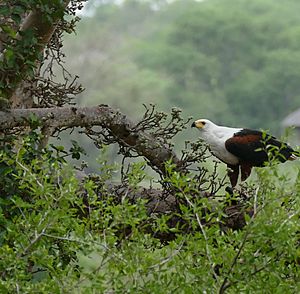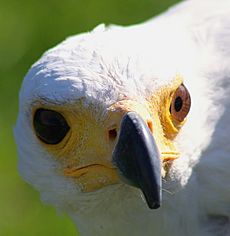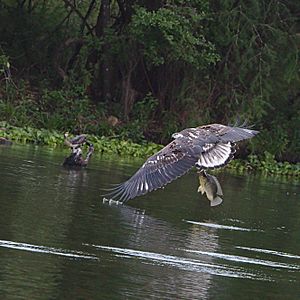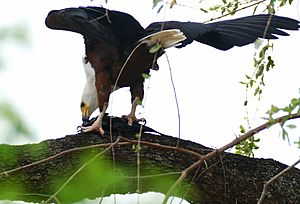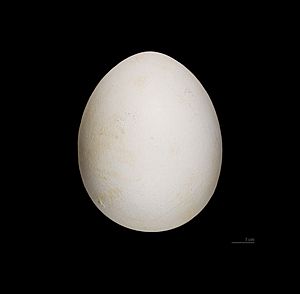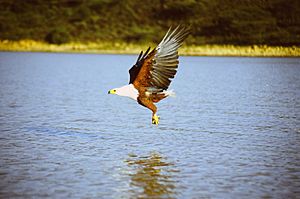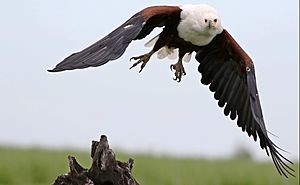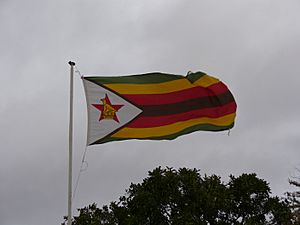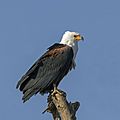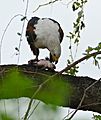African fish eagle facts for kids
Quick facts for kids African fish eagle |
|
|---|---|
 |
|
| Conservation status | |
| Scientific classification | |
| Kingdom: | |
| Class: | |
| Order: | |
| Family: | |
| Genus: | |
| Binomial name | |
| Haliaeetus vocifer |
|
The African fish eagle (Haliaeetus vocifer), also called the African sea eagle, is a big eagle. You can find it across sub-Saharan Africa. It lives near large bodies of water that have lots of fish.
This eagle is the national bird for Zimbabwe, Zambia, and South Sudan. Because it lives in so many places, people know it by many names. It looks a bit like the bald eagle. Even though they are related, they live on different continents. The bald eagle lives in North America.
Contents
About the African Fish Eagle
What's in a Name?
The African fish eagle belongs to a group of birds called Haliaeetus, which means "sea eagles." Its closest relative is the Madagascar fish eagle. This eagle is very rare and is an endangered species.
Like other sea eagles, the African fish eagle has dark talons, beaks, and eyes. Even young eagles have white tails. Its scientific name, Haliaeetus vocifer, means "sea eagle" and "forceful one." This name comes from its loud call.
What Does it Look Like?
The African fish eagle is a large bird. Female eagles are bigger than males. Females weigh about 3.2 to 3.6 kilograms (7 to 8 pounds). Males weigh 2.0 to 2.5 kilograms (4.4 to 5.5 pounds).
Males usually have wingspans around 2 meters (6.6 feet). Females have wider wingspans, about 2.4 meters (7.9 feet). Their body length is about 63 to 75 centimeters (25 to 30 inches).
Adult eagles are easy to spot. They have a brown body and a white head, like the bald eagle. Their wings are large, strong, and black. The head, chest, and tail are bright white. Their face has no feathers and is yellow. Their eyes are dark brown. The beak is yellow with a black tip. It is hooked, which is perfect for catching food.
Young eagles are brown and have lighter eyes. Their feet have rough bottoms. They also have strong talons. These help them grab slippery fish.
The eagle's loud cry is famous. Many people think it sounds like the spirit of Africa.
Where Do They Live?
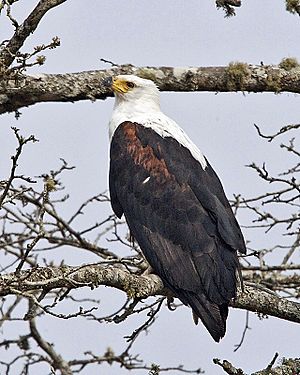
African fish eagles are common near freshwater lakes, rivers, and reservoirs. You might also find them near the coast, where rivers meet the sea. They live all over Africa, south of the Sahara Desert.
Many African fish eagles live around Lake Victoria. They also live near other big lakes in central Africa. These include the Rift Valley lakes.
These eagles can live in many different places. They just need open water with enough food and a good spot to perch. You can find them in grasslands, swamps, marshes, tropical rainforests, and even desert coastlines. They do not live in dry areas with little water.
How Do They Reproduce?
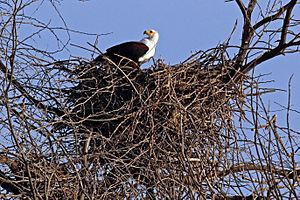
African fish eagles breed during the dry season. This is when water levels are low. They are believed to mate for life. Eagle pairs often use the same nests year after year. They might even have two or more nests.
Because they reuse nests, they can become very large. Some nests can be 2 meters (6.6 feet) wide. They can also be 1.2 meters (3.9 feet) deep. Nests are built in large trees. They are made mostly of sticks and wood.
The female eagle lays one to three eggs. The eggs are mostly white with some reddish spots. The female does most of the sitting on the eggs. The male helps when the female goes hunting.
The eggs hatch after 42 to 45 days. The young eagles learn to fly when they are about 70 to 75 days old. They stay with their parents for up to three more months. After that, young eagles travel around. They might gather in groups away from adult eagles. Eagles that survive their first year can live for 12 to 24 years.
What Do They Eat?
The African fish eagle mainly eats fish. It swoops down from a tree branch to catch fish. It snatches the fish from the water with its strong talons. Then, it flies back to its perch to eat.
Like other sea eagles, the African fish eagle has special bumps on its toes. These help it grip slippery fish. If an eagle catches a fish that is too heavy (over 1.8 kilograms or 4 pounds), it cannot fly with it. Instead, it drags the fish across the water's surface until it reaches the shore.
If the fish is too heavy to even drag, the eagle will drop into the water. It then paddles to the nearest shore using its wings.
African fish eagles also eat other animals. These include waterfowl like ducks, small turtles, baby crocodiles, and frogs. They sometimes eat flamingos, lizards, and dead animals (carrion). They have even been seen carrying off small mammals like hyraxes and monkeys. Sometimes, they might even catch chickens.
Conservation Status
The African fish eagle is listed as "least concern" by the IUCN. This means it is not currently in danger. There are about 300,000 of these eagles. They live across a huge area of 18,300,000 square kilometers (7,065,670 square miles).
National Symbol
This bird is the national bird of Zimbabwe. It appears on the Zimbabwean flag. It is also on the coat of arms for Namibia, Zambia, and South Sudan. It is also on the Zambian flag.
Images for kids
-
African fish eagle in Lake Zway, Ethiopia
-
An African fish eagle feeding on its prey, likely a Mudfish Labeo sp., at the S3 Road West of Skukuza, Kruger National Park, Mpumalanga, South Africa
-
Kazinga Channel, Uganda
-
Lake Naivasha, Kenya
-
Juvenile in flight, Ethiopia
-
Lake Mburo, Uganda
See also
 In Spanish: Pigargo vocinglero para niños
In Spanish: Pigargo vocinglero para niños



